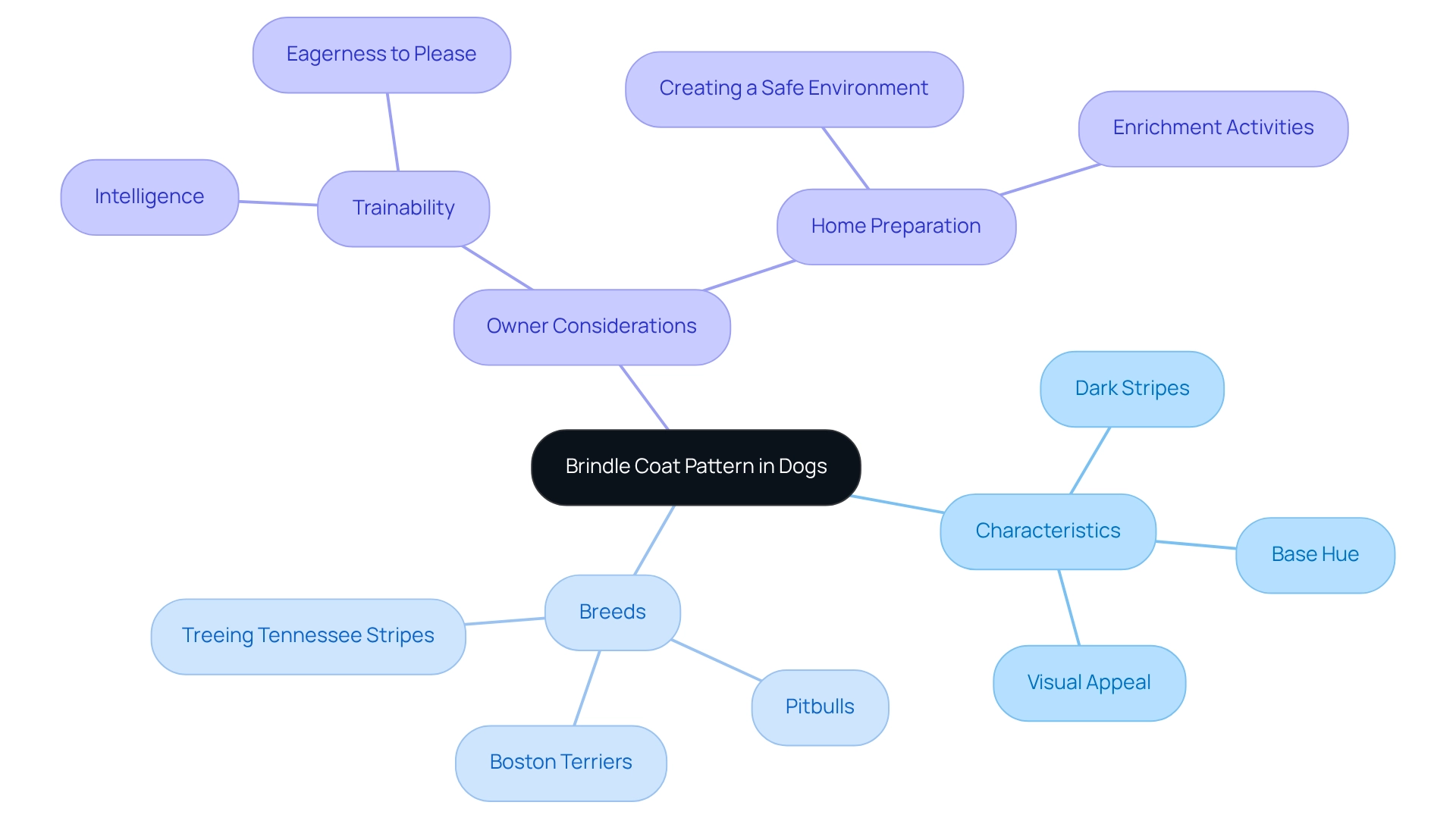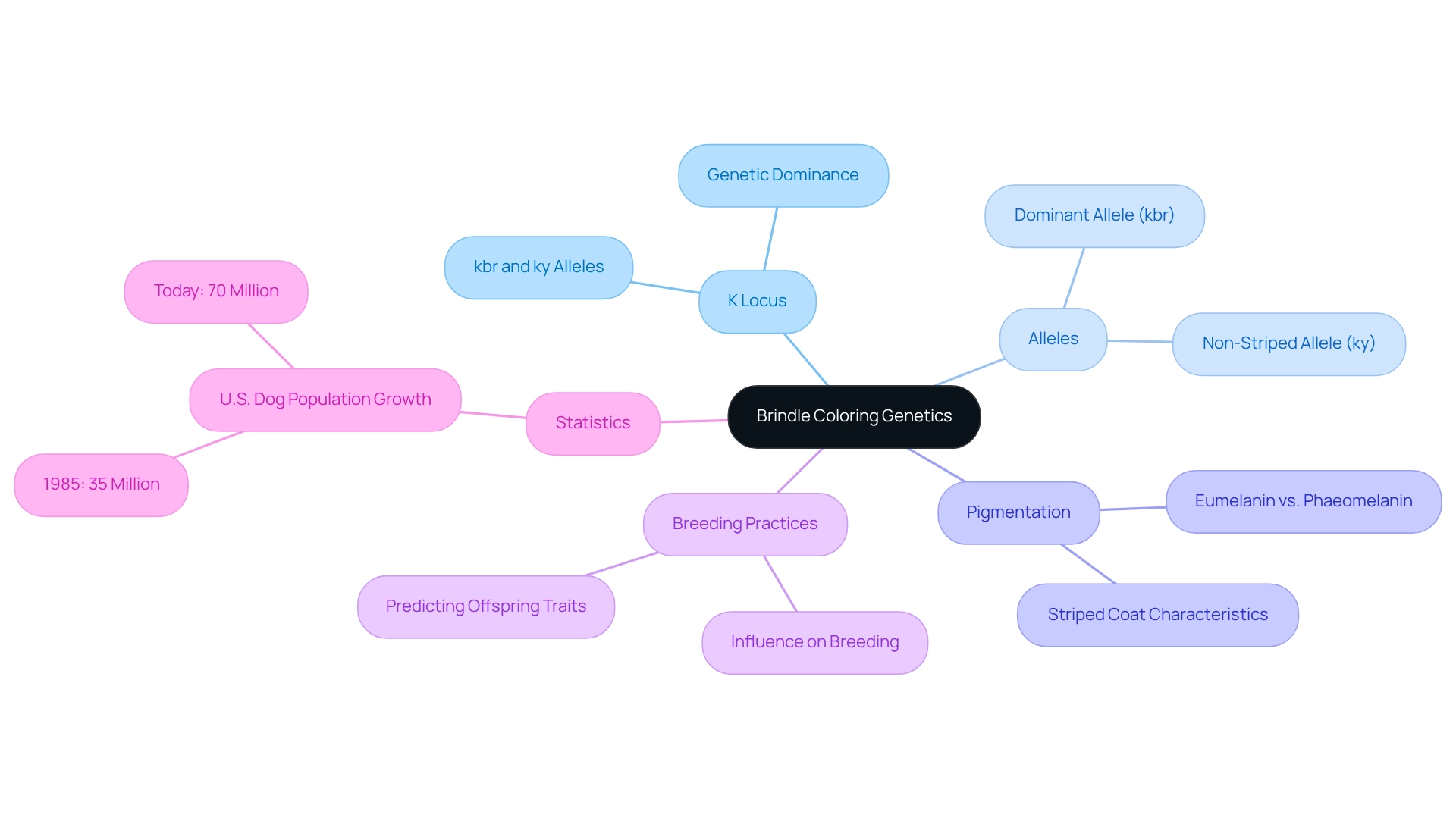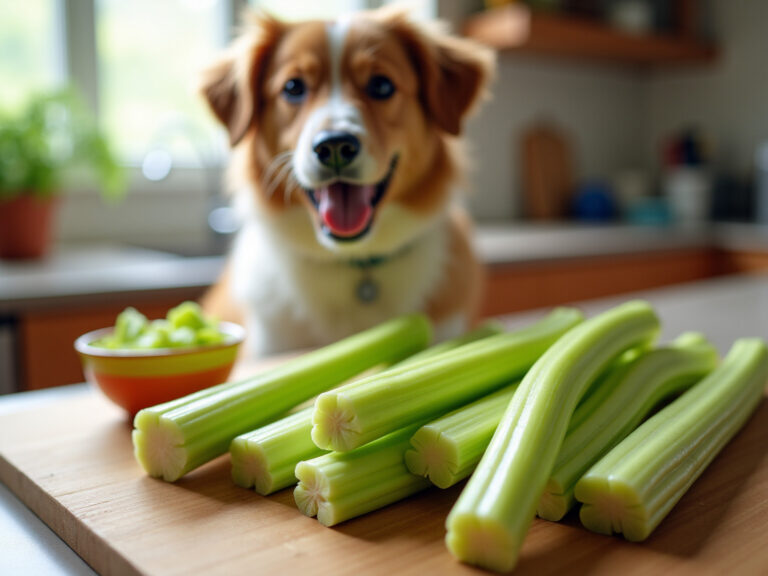Brindle: Understanding the Unique Coat Pattern in Dogs
Overview
Brindle is a truly unique coat pattern in dogs, characterized by dark stripes on a lighter base that often resemble a tiger’s stripes. This beautiful pattern can be found in various breeds, such as Boxers and French Bulldogs. For many pet owners, the sight of a brindle dog can evoke a sense of wonder and admiration.
This article explains that the brindle pattern is influenced by genetic factors, particularly the K locus. Understanding this genetic background not only highlights the beauty of brindle dogs but also sheds light on their desirability among dog enthusiasts. Their distinctive appearance makes them a subject of interest in breeding practices, as many seek to nurture and celebrate these remarkable furry family members.
As you consider the joy that a brindle dog can bring into your life, remember that their unique beauty is just one aspect of what makes them special. Embrace the opportunity to learn more about their care and well-being, ensuring a nurturing environment where they can thrive. Your journey with a brindle companion can be filled with love and connection, making every moment together truly unforgettable.
Introduction
In the vibrant world of canine companions, few features captivate the heart quite like the brindle coat pattern. This striking combination of dark stripes against a lighter base creates an aesthetic that is as unique as it is beautiful, reminiscent of a tiger’s markings. Beyond their visual appeal, brindle-coated dogs are known for their intelligence and trainability, making them not just delightful pets but also versatile companions.
As the fascination with these distinct patterns grows among dog lovers and breeders, understanding the genetic factors, physical traits, and associated breeds becomes essential. This exploration delves into the allure of brindle dogs, unraveling the complexities of their genetics and the joy they bring to families seeking a truly unique furry family member.
Define Brindle: The Unique Coat Pattern in Dogs
Brindle fur design in dogs is unique, characterized by a beautiful blend of dark stripes or streaks on a lighter base hue. Often likened to a tiger’s stripes, this pattern typically showcases black or dark brown stripes on a base layer that can vary from fawn to red. This captivating coloration transcends specific breeds, making it a delightful topic for dog enthusiasts and breeders alike. The visual appeal of these striped coats has led to their popularity across various dog breeds, with many owners drawn to their distinctive appearance.
Studies reveal that striped dogs, such as striped Pitbulls, are not only visually stunning but also possess traits that make them highly trainable. Their intelligence and eagerness to please enhance their adaptability in different environments. For instance, preparing a home for a striped Pitbull involves creating a secure and stimulating atmosphere, which is vital for their adjustment and overall well-being, as highlighted in the case study ‘Preparing Your Home for a Striped Pitbull’.
The frequency of brindle fur can be observed in various breeds, including Boston Terriers and Treeing Tennessee Stripes, each exhibiting this design in unique ways. As we look ahead to 2025, the interest in distinctive dog coat designs continues to flourish, with striped coloration remaining a favored choice among dog owners.
Breeders emphasize the significance of this coloration, noting its allure and the joy it brings to pet owners. Dr. Chyrle Bonk, a veterinarian, reassures us that the information regarding striped dogs is current and aligned with the latest veterinary research. The striped fur design not only enhances a dog’s appearance but also highlights the variety and depth of canine genetics, making it a topic of ongoing interest in the dog breeding community.

Explore Genetic Factors Behind Brindle Coloring
The fur pattern of our beloved dogs, which often features a brindle design, is intricately shaped by genetics, particularly through the K locus, which contains alleles that determine fur color. When one or two copies of the dominant allele (kbr) associated with brindle are inherited, it beautifully supersedes the non-striped allele (ky), resulting in the distinctive striping that many pet owners cherish. This genetic interaction leads to the expression of eumelanin (dark pigment) over phaeomelanin (light pigment), creating the striking contrast characteristic of striped coats. Understanding these genetic elements is essential for breeders who wish to anticipate the chances of brindle-patterned offspring across different dog breeds, ensuring a nurturing environment for their furry family members.
The K locus plays a significant role, as it directly affects the existence of the brindle pattern in canines. Research indicates that the inheritance of the brindle pattern gene is complex, with various genetic interactions influencing the final appearance of a dog’s fur. A notable case study titled “The Complexity of Canine Genetics” illustrates how different genes collaborate to produce traits like coat color, emphasizing the challenges in predicting genetic outcomes in our canine companions. Expert opinions on the K locus and the brindle genetic component further highlight the importance of these elements in breeding practices, reassuring breeders of their significance.
Statistics reveal that the U.S. dog population has grown from roughly 35 million in 1985 to about 70 million today, reflecting a rising interest in various dog breeds, including those with striped patterns. As breeders and pet owners become more aware of the genetic factors influencing brindle coloring, they can make informed choices that enhance both the health and aesthetic appeal of their cherished pets. By nurturing this knowledge, we can create a loving and supportive environment for our furry friends.

Identify Physical Traits of Brindle-Coated Dogs
Brindle dogs are truly captivating, showcasing a delightful variety of physical traits that differ significantly among breeds. The signature design features brindle patterns with distinctive lines or streaks that can be sharply defined or softly blended, creating a unique appearance. The base colors are diverse, ranging from fawn to red or cream, while the stripes typically vary from black to dark brown. Breeds such as Boxers and Bull Terriers often have a brindle pattern, proudly displaying these characteristics, which makes them easily recognizable and beloved companions. Additionally, Goldendoodles, known for their hypoallergenic qualities, easy training, and sociable nature, can also exhibit striped markings, further enhancing their charm as family pets.
The appearance of these stripes can vary based on the dog’s coat type, whether it’s short and smooth or long and wiry. Understanding these traits is essential for recognizing the beauty of striped designs across various breeds, as they contribute to the unique allure of these animals. For example, the impressive abilities of Brindle Pit Bulls in obedience training are exemplified by Moxie, who earned the AKC Obedience Award in 2012. This highlights the potential for dogs with a brindle pattern to excel in training with dedication and consistency. Moreover, the interplay of different alleles can lead to surprising color outcomes in breeding, which is vital for comprehending the genetic basis of brindle patterns. The variability in appearance among dogs with a brindle coat speaks to the fascinating complexity of canine genetics. When it comes to teaching your Pit Bull with a brindle coat to interact well with children, consistent training, positive reinforcement, and supervised interactions are key. This underscores the importance of customized training approaches for different breeds, ensuring a nurturing environment for your furry family members.
Lastly, American Bulldogs, celebrated for their loyalty, intelligence, and energy, require focused training and ample exercise. This illustrates how physical traits can influence behavior and care needs. By embracing these insights, you can foster a deeper understanding of brindle dogs and their unique characteristics, creating a loving and supportive home for your beloved pets.
Examine Rarity and Breeds Associated with Brindle
Brindle patterns are notably uncommon compared to solid fur colors, making them particularly appealing to dog lovers and families looking for unique brindle pets. Breeds such as the Boxer, French Bulldog, and Treeing Tennessee brindle are especially recognized for their striking patterned coats. Moreover, this beautiful pattern can also appear in a brindle variation in mixed breeds and less common varieties like the Plott Hound and Dutch Shepherd. The rarity of these designs stems from genetic factors and selective breeding practices, making these uniquely coated canines especially desirable for those who appreciate their distinctive appearance.
At Adventure Den, we truly understand the importance of providing a safe and nurturing experience for pets, aligning perfectly with the needs of families considering such a canine as their next companion. We offer a variety of services tailored specifically to meet the needs of these unique breeds, including personalized care, engaging play areas, and advanced security features. To attract new clients interested in distinctive breeds like striped dogs, Adventure Den proudly presents a special introductory promotion for first-time visitors, allowing them to enjoy our premium services at a favorable rate. This thoughtful approach has proven successful in expanding our customer base, as families seek trustworthy and loving care for their pets.
Integrating expert knowledge and research can further enhance understanding of coat variations. For instance, studies show that striped fur is rarer in certain breeds, making them a sought-after choice among dog enthusiasts. As we approach the BSAVA Congress 2025, important discussions will arise regarding the genetics of coat designs, providing further insight into the rarity of striped dogs. Recognizing the breeds associated with brindle patterns not only enriches potential owners’ knowledge but also assists them in making informed decisions when selecting a beloved canine companion.
Conclusion
The allure of brindle-coated dogs lies not only in their striking appearance but also in their genetic complexity and trainability. The unique brindle pattern, characterized by dark stripes on a lighter base, has captivated dog lovers across various breeds, from Boxers to French Bulldogs. Understanding the genetic factors behind this coat pattern is essential for breeders and enthusiasts alike, as it reveals the intricate interplay of alleles that create these beautiful markings.
Physical traits associated with brindle dogs further highlight their diversity, with variations in stripe definition and base colors that make each dog unique. This complexity extends to their behavior and training potential. Many brindle breeds, such as Pitbulls and Goldendoodles, demonstrate intelligence and adaptability, making them excellent family pets.
Additionally, the rarity of brindle patterns enhances their desirability, appealing to those seeking a distinctive canine companion. As awareness of the genetic and physical traits of brindle dogs grows, so too does the appreciation for their beauty and character. Understanding these aspects not only aids potential owners in making informed choices but also fosters a deeper connection with these remarkable dogs. Embracing the unique qualities of brindle-coated breeds enriches the bond between humans and their furry family members, celebrating the diversity and joy that each brindle dog brings into a home.
Frequently Asked Questions
What is brindle fur design in dogs?
Brindle fur design is characterized by a blend of dark stripes or streaks on a lighter base hue, often resembling a tiger’s stripes. The pattern typically features black or dark brown stripes on a base that can range from fawn to red.
Which dog breeds commonly exhibit brindle fur?
Brindle fur can be observed in various breeds, including Boston Terriers and Treeing Tennessee Stripes, each showcasing this unique design in different ways.
Are striped dogs, like striped Pitbulls, trainable?
Yes, studies indicate that striped dogs, including striped Pitbulls, are highly trainable due to their intelligence and eagerness to please, which enhances their adaptability in various environments.
What considerations should be made when preparing a home for a striped Pitbull?
Preparing a home for a striped Pitbull involves creating a secure and stimulating environment, which is essential for their adjustment and overall well-being.
Why is the brindle fur design popular among dog owners?
The visual appeal of brindle coats, characterized by their distinctive striped appearance, has led to their popularity across various dog breeds, attracting many owners.
What is the significance of brindle coloration in dog breeding?
Breeders emphasize the allure of brindle coloration, noting that it enhances a dog’s appearance and showcases the variety and depth of canine genetics, making it a topic of ongoing interest in the dog breeding community.
Is the information about striped dogs current and reliable?
Yes, Dr. Chyrle Bonk, a veterinarian, assures that the information regarding striped dogs is current and aligned with the latest veterinary research.







